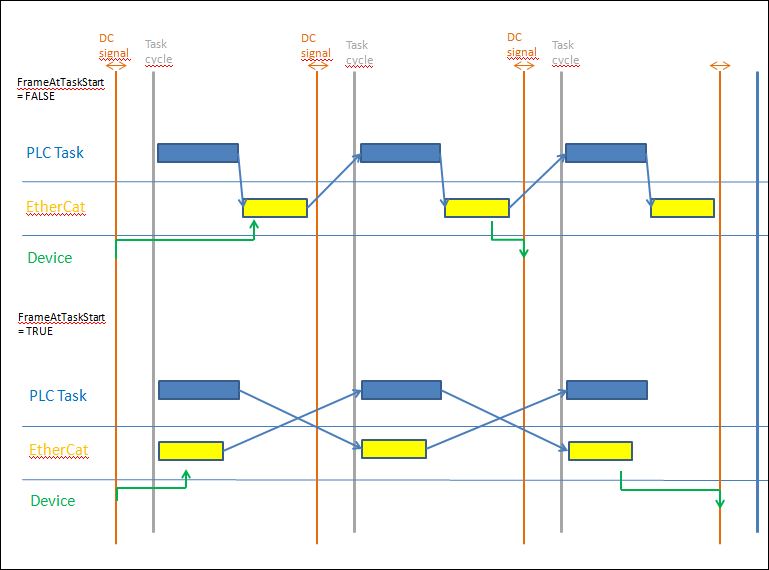Implicit Instance of the Master
Object: EtherCAT Master
An instance of the type IoDrvEtherCAT is created for each EtherCAT master that is inserted into the device tree. The name of the instance corresponds to the name of the master in the device tree. The availability of the instance is displayed in the IEC Objects tab of the device editor.
See also
|
Name |
Data type |
Description |
|---|---|---|
|
|
|
Rising edge: Master is restarted, all configuration parameters are reloaded. |
|
|
|
|
|
Name |
Data type |
Description |
|---|---|---|
|
|
|
|
|
|
|
If Distributed Clocks are used, the PLC is synchronized with the first EtherCAT slave for which the DC option is activated.
The output becomes
When starting the PLC the output is |
|
|
|
Output becomes
|
|
|
|
Output becomes |
Examples
-
Initiate a restart of the master via the xRestart variable:
EtherCAT_Master.xRestart := xRestart; -
Initiate stopping of the communication on the bus via the xStop variable:
EtherCAT_Master.xStopBus := xStop; -
Call the master in order to get information about the success of the download of the configuration parameters:
EtherCAT_Master();xFinish := EtherCAT_Master.xConfigFinished;
|
|
TRUE: In the event of a communication breakdown the master immediately attempts to restart the slaves Default: FALSE |
|
|
TRUE: Reading of the configuration is complete and the user can edit the settings, for example in order to add self-defined SDOs. |
|
|
Time window for XDistributedClockInSync. Jitter must be within the window, so that the XDistributedClockInSync output signal remains permanently TRUE. Default: 50 microseconds (200 microseconds when using CODESYS SoftMotion) |
|
|
Returns the current time of day of the first slave with 'Distributed Clock'. This time is the reference time for all other slaves and the PLC itself. |
|
|
Integral factor for the Distributed Clock control loop Default: 20 |
|
|
Proportional factor for the Distributed Clock control loop Default: 25 |
|
|
Distributed Clock synchronization on the master. If set to
Default: |
|
|
Distributed Clock synchronization on the master.
Default: |
|
|
EtherCAT signals are normally dispatched by the bus cycle task and additionally from each task that uses slave outputs. In the bus cycle task all outputs are written and all inputs are read. In other tasks the outputs are transferred one more time in order to get them written to the corresponding slaves immediately. In this way an attempt is made to keep the dead time until writing as short as possible. Together with the distributed clocks this can cause problems in some devices, for example if servo controllers are not synchronized with the Sync interrupt, but use the time of writing for internal synchronization. In this case multiple write accesses can occur during a cycle. If
Default: |
|
|
Pointer to the first slave underneath the master |
|
|
Default: |
|
|
Pointer to linked master list -> previous master |
|
|
This property returns a string with the last message of the EtherCAT stack. |
|
|
Pointer to linked master list -> next master |
|
|
This property returns the number of actually connected slaves. |
|
|
Timeout for the opening of the network adapter. Default value is 4 seconds. |
|
|
Used for splitting the frame into two parts. The first part contains the process data, and the second part contains the asynchronous mailbox communication and status flags. Due to the splitting, the process data is received earlier and therefore the jitter of the PLC has less effect on the slaves. |
|
|
Used for influencing the starting behavior of the stack. The EtherCAT stack normally stops if, for example, five servo controllers are configured in the project, but only three are connected. However, if |

See also